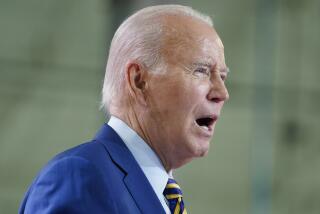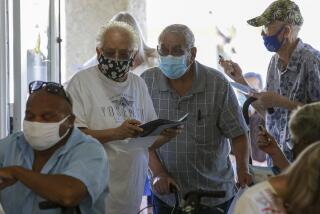U.S. health spending hits $3 trillion as Obamacare and rising drug costs kick in
- Share via
U.S. healthcare spending grew 5.3% last year to $3 trillion, another sign that a historic slowdown in medical inflation may be ending, a new federal report shows.
The massive expansion of insurance coverage under the health law and rapid growth in specialty drug spending fueled the uptick in medical costs, officials said. Annual spending growth was 3.7%, on average, during the last five years.
The country spent $9,523 per person on healthcare in 2014, including Medicare, Medicaid and private health insurance. That’s far higher than what other developed countries pay, and healthcare spending now accounts for 17.5% of the U.S. economy.
Experts aren’t predicting a return to double-digit increases in medical spending. But the latest trend underscores how difficult it will be for policymakers, employers and insurers to control healthcare costs going forward.
NEWSLETTER: Get the day’s top headlines from Times Editor Davan Maharaj >>
The upswing could further squeeze American workers. Health insurance premiums and deductibles keep taking a bigger bite of their paychecks, as employers shift more healthcare costs to employees.
“Two main factors were responsible for health spending growth in 2014 -- coverage expansion associated with the Affordable Care Act and faster growth in prescription drug spending,” said Anne B. Martin, an economist at the Centers for Medicare and Medicaid Services.
“It is unknown how these drivers of healthcare spending will affect trends over the next few years as the new health insurance landscape continues to evolve,” Martin added.
Wednesday’s report by government actuaries found that the percentage of Americans with health insurance reached 88.8% in 2014, the highest share since 1987.
That came from more people buying private health insurance with the help of federal premium subsidies, and more individuals enrolling in Medicaid programs that were expanded in more than 25 states. Total Medicaid enrollment increased by 7.7 million in 2014.
Prescription drug spending soared 12.2% last year to $297.7 billion. That was up sharply from a 2.4% increase in 2013.
Federal actuaries cited the introduction of high-priced specialty drugs for hepatitis C as well as price increases for other brand-name medications.
Rising drug costs and efforts to combat them have become high-profile issues on the presidential campaign trail and on Wall Street.
This week, a U.S. Senate report criticized Gilead Sciences Inc. for pricing its hepatitis C drug Sovaldi at $84,000 per patient for a standard 12-week treatment. The company also introduced another expensive hepatitis C drug, Harvoni.
Gilead disagreed with the report’s conclusions and said the company “responsibly and thoughtfully priced Sovaldi and Harvoni.”
Government actuaries found smaller increases in spending for both physician services and hospital care compared to prescription drugs. Those two categories went up about 4% in 2014.
From 2009 to 2013, U.S. healthcare spending grew annually at less than 4%. That was the lowest rate of growth in half a century, and sparked considerable debate about the underlying reasons.
Many health economists and industry experts attributed the slowdown primarily to lingering effects of the Great Recession, when millions of Americans cut back on medical care.
But health officials and other analysts have pointed to fundamental changes in healthcare reimbursement and the delivery of care spurred by the Affordable Care Act.
The Obama administration pointed out that the 5.3% increase in 2014 is still below the 6.9% average growth rate during the decade prior to the 2010 health law being enacted. Officials also predicted the spending increases tied to the coverage expansion will fade in the coming years.
“Today’s numbers on national health spending show that as millions more Americans gained coverage in 2014, healthcare spending growth stayed well below the trend seen prior to the Affordable Care Act,” said Richard Frank, an assistant secretary at the Department of Health and Human Services.
There are a number of forces at play that bear watching in the months and years ahead.
Some experts say the growing use of narrow provider networks by employers and health insurers and a shift away from conventional fee-for-service reimbursement for medical providers could be potent cost-containment tools.
Other health economists express concern about consolidation among hospitals, physician groups, drugmakers and insurers reducing competition and pushing up prices.
Twitter: @chadterhune
MORE FROM BUSINESS
Yellen signals rate hike is coming later this month
Fed says more consumer spending, housing boost U.S. growth
L.A. motorists are paying 75 cents more than U.S. average for a gallon of gas
More to Read
Inside the business of entertainment
The Wide Shot brings you news, analysis and insights on everything from streaming wars to production — and what it all means for the future.
You may occasionally receive promotional content from the Los Angeles Times.











